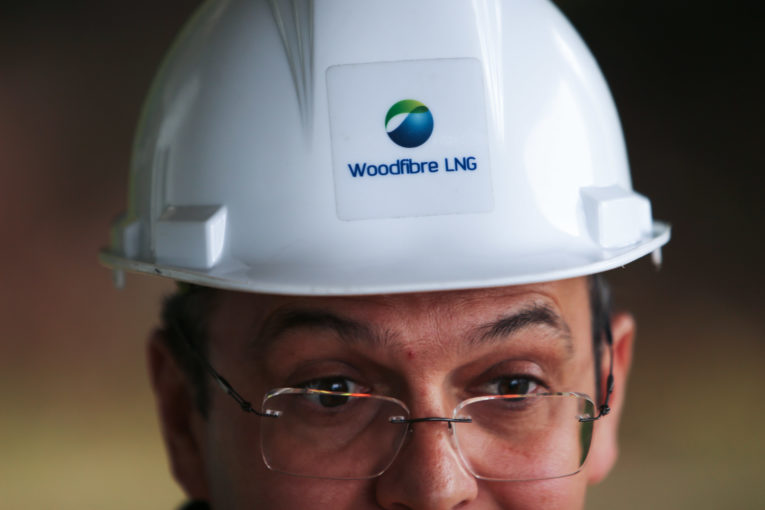
Two liquefied natural gas proponents on either side of Canada’s coastlines are inching toward final investment decisions for their projects after securing key deals.
On Thursday, Woodfibre LNG Export Pte Ltd. said it signed its first major deal to sell LNG to the trading unit of BP Plc. The energy giant will buy 0.75 million tonnes per annum of LNG over 15 years from the project based in Squamish, B.C., with first delivery expected in 2023.
The $1.6 billion project, being developed by Hong Kong-based Pacific Oil & Gas Ltd., has reportedly targetted a final investment decision this summer.
“Woodfibre LNG is a tremendous opportunity for British Columbia and Canada to get clean natural gas to growing markets in Asia,” said David Keane, president of Woodfibre LNG.
A day earlier, Pieridae Energy said it’s acquiring Shell Canada’s Alberta gas assets for $190 million. The Calgary-based company, which has been accumulating natural gas assets, has now secured the remaining conventional natural gas supply needed for its 10 million tonnes per year Goldsboro plant in Nova Scotia.
Its plan is to export to Europe — mainly Germany, where it has a contract in place with the Düsseldorf-based gas utility Uniper SE.
Alfred Sorenson, chief executive officer of Pieridae, said the next steps for the company were to get a fixed price for the lump sum contract, which is “well on its way,” and to finalize long-term financing.
“… So depending on the timing it’ll either be the very end of this year or the very beginning of 2020 that we’ll be ready for a final investment decision,” Sorenson told the Financial Post.
The Shell assets will allow Pieridae to access up to US$1.5 billion in credit support from the German government under the Untied Loan Guarantees program to develop the upstream assets as part of the Goldboro LNG Project.
Ian Archer, the associate director of North American natural gas at IHS Markit, sees several reasons for the Germans to team up with Pieridae.
“It helps the Germans get off of Russian gas, which is what they’re interested in doing. But one of the stipulations is that it has to be non-frack gas, which is one of the reasons they bought this Shell gas.”
A Nova Scotia base means a delivery time of six days to markets in Germany, the U.K. and Netherlands, faster than the U.S. or Russia can offer.
A Nova Scotia base of operations also means a delivery time of six days to markets in Germany, the U.K. and the Netherlands, faster than the U.S. or Russia can offer.
At the other end of the country, Woodfibre has a licence to export 2.1 million tonnes of LNG for 40 years, primarily to the Asian market, which is expected to account for 75 per cent of global demand.
Archer envisions these developments as the next logical step for the Canadian industry, as it slowly challenges major gas rivals Australia and Russia.
Royal Dutch Shell and its Asian partners are also building the $40 billion LNG Canada Ltd. project that’s expected to put Canada firmly on the LNG map, but the progress of smaller projects suggests the industry is revving up and connecting to markets beyond the U.S.
“North American gas industries are very saturated. We see an oversupply continuing and it’s going to remain a low-price environment for quite some time,” said Archer. “So if Canada wants to grow the gas business, the next logical step would be connecting to global markets — and both projects continue to advance that.”
Sorenson sees these developments as a natural way to evolve from an outdated relationship with the United States.
“The natural gas industry in Canada in the last 20 years relied on U.S. as a free option to put gas into the marketplace,” said Sorenson. “Now that the Americans don’t need our gas anymore, if we want to continue to have a natural gas industry that’s bigger than just supplying to Alberta, we have to look farther afield.”
North American gas industries are very saturated. We see an oversupply continuing and it’s going to remain a low-price environment for quite some time
Ian Archer, associate director, North American natural gas, IHS Markit
At the same time, Archer says these developments are unlikely to lift depressed natural gas prices in Alberta, as the projects won’t be online until the mid-2020s.
“By that time, the situation in Alberta may have improved anyway because of the improved connectivity within the NGTL system (TC Energy’s Nova Gas Transmission Ltd.),” said Archer. “If all these projects go ahead, it wouldn’t surprise me to see a bit of price uplift.”
The two projects are gearing up amid a predicted LNG shortage in the mid-2020s. IHS Markit predicts a four per cent growth in annual global gas demand.
For Archer, Woodfibre’s is the more positive development, as Pieridae may have to deal with regulatory issues when it comes to delivery. Woodfibre is building much closer to their supply sources and their biggest challenge was primarily acquiring customers, which they have partially resolved through a deal with BP Plc.
“The infrastructure is there but there could be issues in Quebec because I believe they need to expand the pipeline in Quebec,” said Archer. “That would involve a regulatory hearing and may involve some opposition.”
For his part, Sorenson does not see this as a major issue.
“The natural gas is going from Western Canada to Eastern Canada via TransCanada (now TC Energy) and once liquefied it goes on a boat to Germany,” said Sorenson. “There is some work that needs to be done on the eastern end of the pipeline but TransCanada is very confident they can get it done and in time for the in-service date of 2024.”
• Email: [email protected]
You can read more of the news on source
